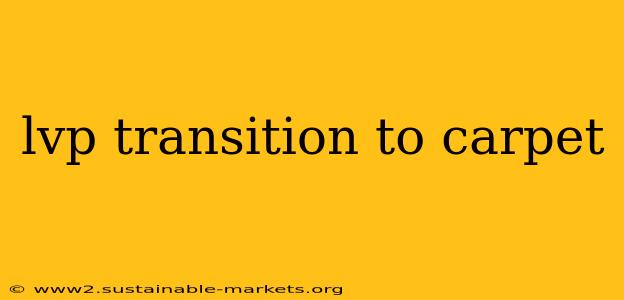Luxury vinyl plank (LVP) flooring has surged in popularity due to its durability, water resistance, and stylish appearance. However, many homeowners find themselves needing to transition from LVP to carpet in different areas of their home, creating a visually appealing and functional connection. This comprehensive guide will walk you through the process, offering tips and techniques to achieve a professional-looking result.
Understanding the Challenges of LVP to Carpet Transitions
Transitioning from LVP to carpet presents unique challenges compared to other flooring transitions. The differing thicknesses and materials require careful planning and execution to avoid tripping hazards and unsightly gaps. Key considerations include:
- Height Difference: LVP is typically thinner than carpet, creating a noticeable step-up or step-down if not properly addressed.
- Material Compatibility: Choosing the right transition strip is crucial for a secure and aesthetically pleasing finish.
- Subfloor Preparation: Ensuring a level and stable subfloor is essential for both the LVP and carpet installation.
Choosing the Right Transition Method
Several methods can effectively transition from LVP to carpet, each with its own pros and cons:
1. Transition Strips: The Most Common Solution
Transition strips are readily available at most home improvement stores and offer a simple, effective way to bridge the gap between LVP and carpet. They come in various styles, materials (metal, wood, vinyl), and finishes to match your décor. Choosing a strip that matches the color and style of your flooring is key to a seamless look.
Types of Transition Strips:
- T-Molding: A popular choice, T-molding sits on top of both flooring types, concealing the height difference and creating a smooth transition.
- Reducer Strip: Used when transitioning from a thicker floor covering (carpet) to a thinner one (LVP), it gradually slopes down to eliminate a significant height difference.
- Ramp: Similar to a reducer strip but typically used for larger height discrepancies, creating a gentler incline.
2. Carpet to LVP Reducer: A More Subtle Approach
A carpet-to-LVP reducer strip is specifically designed for this type of transition. It creates a smooth, sloping transition, minimizing the height difference and providing a cleaner look than a standard T-molding.
3. Custom Solutions for Unique Situations
For complex transitions or unique design requirements, consider consulting a professional flooring installer. They can offer custom solutions, such as using custom-made thresholds or creating a built-in transition using trim molding.
Step-by-Step Guide to Installing a Transition Strip
Once you've chosen your transition method, follow these general steps:
- Measure and Cut: Accurately measure the transition area and cut the transition strip to the correct length, ensuring a snug fit.
- Prepare the Surface: Clean both the LVP and carpet edges thoroughly. Ensure the flooring is level and free of debris.
- Install the Strip: Follow the manufacturer's instructions for installation. This typically involves securing the strip to the LVP and/or carpet using adhesive or nails.
- Caulk (Optional): Apply caulk to any gaps between the transition strip and the flooring for a watertight seal and to prevent dust and debris from accumulating.
- Inspect and Finish: Inspect your work for any imperfections. Make any necessary adjustments before proceeding with other flooring installations.
Choosing the Right Materials: Quality Matters
Investing in high-quality transition strips ensures a durable and aesthetically pleasing finish. Opt for materials that are resistant to wear and tear, moisture, and discoloration.
Beyond the Basics: Enhancing the Transition
For a truly polished look:
- Matching Colors and Finishes: Choose transition strips that complement the colors and finishes of both the LVP and carpet.
- Consider the Room's Style: Select transition strips that match the overall style of your room, whether it's modern, traditional, or rustic.
- Professional Installation: For a flawless finish, consider hiring a professional flooring installer.
By following these steps and considerations, you can successfully transition from LVP to carpet, creating a beautiful and functional space in your home. Remember that proper planning and attention to detail are crucial for achieving a professional-looking result.

